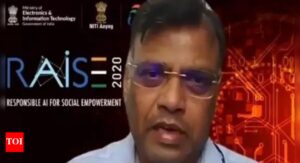India’s data economics: The good, the bad and the missing | India News

NEW DELHI: India’s rapid ascent at the economic, welfare and global front has been the talk of the town in BJP’s headquarters and political rallies for more than a decade now, under Prime Minister Narendra Modi‘s leadership.
Whether it’s India becoming the third largest economy, or 25 crore people escaping poverty during PM Modi’s tenure, it’s all true on record.However, the text and context seem to mismatch.
From the country’s meek performance on Global Hunger Index, to its soaring heights on national multidimensional poverty, it all comes out in the central government’s favour at the end.
The happy data
PM Modi and the BJP leaders have often raved about becoming the third largest economy as an achievement of the efforts of the central government. However, economists and opposition leaders have warned against the “hype” and said that the country must focus on low per capita and structural issues that need to be addressed to meet its potential.
“The greatest mistake India can make is to believe the hype. We’ve got many more years of hard work to do to ensure the hype is real. Believing the hype is something politicians want you to believe because they want you to believe that we have arrived,” former RBI governor Raghuram Rajan told Bloomberg.
Likewise, former RBI governor C Rangarajan had said: “We are the 5th largest economy and may become the third- or fourth-largest economy in the next few years. However, for India to become a developed country by 2047, i.e. a hundred years from its independence, India’s per capita income must be at $13,000 (Rs 10.58 lakh approx). Currently, the per capita income is $2,000 (Rs 1.65 lakh approx).”
The sad data
India has officially rejected the Global Hunger Index calling it a “flawed measure” while also patting itself for an improved rank in the same index citing efforts made by the central government schemes.
Additionally, it has a dedicated unit — Global Indices for Reform and Growth (GIRG) — to exclusively monitor at least 30 indices. An investigation by Reporter’s Collective claimed that the central government has tried to “reach out to agencies that publish the indices to convince them to change their parameters – what they measure – if India is doing badly in their reports, which it often does.”
It also claimed that the government reached out to the publishers of the hunger index and urged them to “make critical changes to how they score the countries”.
“One of them was to focus less on malnutrition among children, an indicator where India performed poorly – even by the government’s own admission – and dragged down its overall score,” the report said.
“The Global Hunger Index is a flawed measure of ‘hunger’ and does not reflect India’s true position. Three of the four constituent indicators (stunting, wasting and child mortality) are related to health of children and cannot be taken to reflect hunger in the population,” the government said in Lok Sabha when India got a rank of 105 of 125 countries last year.
Adding further, the government said that there has been an “improvement in India’s rank in 2024 compared to 2023, which is mainly attributable to improvement in the fourth constituent indicator, namely prevalence of undernourishment (PoU), of the index.”
The missing data
We have a population of 140 crore or 1.4 billion. But we haven’t counted ourselves since 2011 and on papers, we are still 1.2 billion in number, leaving over 20 crores unaccounted for.
Another significant backlog in government data releases has emerged, with 16 critical datasets delayed and nine Union ministries yet to publish their annual reports—some pending for several years. Additionally, the census of India remains three years overdue, a report by India Spend reveals.
The delays affect crucial sectors such as health, environment, demography, agriculture, and criminal justice, raising concerns about transparency and data-driven policymaking.
Political experts have linked the delay in census to proposed delimitation plans to suit the BJP.
The unavailability of current census data also has serious policy implications with Congress leader Sonia Gandhi recently raising the issue in the Parliament. She had said the lack of updated data was leaving around 14 crore people deprived of benefits under the food security law (NFSA).
Furthermore, the lack of data in the field of environment raises questions on the effectiveness of policy implications at a time when electoral battles are being fought on pollution related issues.
Environmentalists have raised concerns over this with Vimlendu Jha, founder of Swechha, saying, “Modi has downsized the role of the environment ministry.”
“This is an infrastructure and growth driven government and environment is going to be an impediment to that narrative,” he added, citing the Char Dham project as the recent example.
The poor that aren’t
PM Modi has claimed that over 25 crore people came out of poverty during his tenure. A Niti Aayog report has also claimed an over 18% decline in multidimensional poverty over the last nine years. “Multidimensional poverty in India was found to decline from 29.17% in 2013-14 to 11.28% in 2022-23 with about 24.82 crore people escaping poverty during this period,” the report said.
However, several economists have raised concerns over the methodology used to calculate these numbers, especially considering the impact of Covid 19.
Pew Research Centre in a study claimed that 75 million people slipped into poverty in the country since the Covid began. Another report by Azim Premji University in Bangalore said that 230 million slid into poverty, contradicting the happy picture presented by the Centre.
“The health and education indicators which have the highest contribution to MPI were most adversely impacted in the pandemic year 2020–21. Using data from the fifth National Family Health Survey of 2019-21 must have led to substantial errors in the deprivation index based on the survey, opening the conclusions of the Niti Aayog report to suspicion,” Arun Kumar, retired JNU economics professor, told DW.







